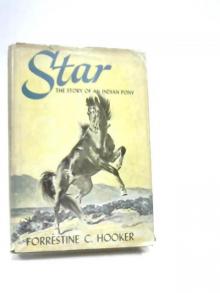


Star: The Story of an Indian Pony
Augusta Huiell Seaman

STAR
The Story of an Indian Pony
by
FORRESTINE C. HOOKER
With an Introduction by Lieut.-General Nelson A. Miles, U.S.A.
Jacket Painting by Charles Livingston Bull
The Sun Dial Press, Inc.Garden City, New York
Copyright, 1922, by Doubleday, Page & Company.All Rights Reserved.Printed in The United States at theCountry Life Press, Garden City, N. Y.
TO YOU, THE ONE
Like a ray of light in a stormy sky your love has encouraged and guided me through years when the dim, rough trail was hard to follow.
_Son of Running Deer, daughter of the swiftest racer ofall the Comanche ponies_]
FOREWORD
The recording of historic facts and events in the romance of a storymust be interesting and instructive to the readers; especially when thescenes occurred in a vast country, formerly occupied by an ancient anddeparted race and later by one now rapidly disappearing.
In vain might we search history for the record of a people who contendedas valiantly against a superior race, overwhelming numbers, and whodefended their country until finally driven toward the setting sun, apractically subjugated nation and race. The art of war among the whitepeople is called strategy, or tactics; when practised by the Indians itis called treachery.
Their wealth consisted of their herds of horses--which the WesternIndians obtained from the Mexicans after the Spanish had invadedMexico--their lodges and the few appliances for camp-life. Theyworshipped the God of nature, and the Great Spirit was their omnipotentJehovah. They believed that death was a long journey to the HappyHunting Grounds. They were grateful for the abundance of the earth--thesunshine, air, water, and all the blessings of nature--and believed thatall should share them alike. For one to wish to monopolize any part ofthe earth was to them the manifestation of a grasping disposition. Oftenthe men of the most influence and greatest popularity in the tribe werethe poorest, or those who gave most to others.
They believed that the Great Spirit had given them this beautifulcountry with its natural resources, advantages, and blessings for theirhome.
One great cause of disaffection among the Indians was the destruction oftheir vast herds of buffalo, which seemed like ruthless sacrifice.Within a few years millions of buffalo were killed for their hides, andthousands of white men, the best rifle-shots in the world, were engagedin the business.
Among their own tribe and people they had a code of honour which allrespected. An Indian could leave his horse, blanket, saddle, or rifle atany place by day or night and it would not be disturbed, though thewhole tribe might pass near. This could not be done in any community ofwhite people.
These conditions existed in 1874, when the Southwest Indians assembledat Medicine Lodge and decided to drive out the buffalo hunters.
In August, 1874, I was directed to organize a command at Fort Dodge, onthe Arkansas River in southwestern Kansas, and move south against thehostile Indians. Other commands were ordered to move: one east from NewMexico, under Major Price; one north from Texas, under GeneralMackenzie; one west from Indian Territory, under Colonel Davidson, TenthCavalry.
My command consisted of two battalions of eight troops of cavalry,commanded by Majors Compton and Biddle; one battalion of four companiesof infantry, commanded by Major Bristol; a company of friendly Indians,a detachment of artillery, and a company of civilian scouts and guides.These latter were mostly hunters and expert riflemen, familiar with thecountry.
In one of the many engagements with the hostile Indians Captain Frank D.Baldwin (now Major General) a very gallant officer, recaptured twolittle captive white girls, Julia and Adelaide Germaine, seven and nineyears old, whose father, mother, brother, and older sister had beenmassacred. From the children we learned of their two sisters, still inthe hands of the savages, and we made it a condition that they should bebrought in safely and surrendered with the whole tribe, which was doneimmediately on receipt of my demand. The other two girls had beenbrought by order of Chief Stone Calf to a tent next his own, where theywere treated with marked care and consideration until formallysurrendered to us.
That campaign, lasting for many months, closed after most difficult andlaborious efforts on the part of the troops, with the satisfactoryresult that the vast southwestern country has been free from theterrifying and devastating presence of hostile Indians, and the citizensof the States of Kansas, Colorado, Oklahoma, Texas, and New Mexico haveenjoyed an era of peace. Scarcely a hostile shot has been heard in thatcountry since that year.
In a report to Lieutenant-General P. H. Sheridan, Commanding General ofthe U. S. Army, November 23, 1874, which was published in report ofSecretary of War, Vol. I, 1875, I said:
"It would have been better for the Indians had they been considered apart of the population of the United States and dealt with generously;and when forced on reservations--which is always the case--letreservations be reasonable in size, subject to special rule andgovernment until the Indians are fitted to obey the ordinary laws of thecountry which have been made to control educated and intelligent whitepeople.
"If the Indians had always been humanely and honestly dealt with, therewould have been but few of the troubles which have occurred in the manyyears gone by."
Signature: Nelson A. Miles, Lieut.-General US Army]
July 21, 1922 Washington, D. C.
STAR:
_The Story of an Indian Pony_














